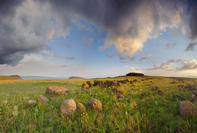The Voortrekkers
In the 1700s and early 1800s, several European hunters and explorers ventured into the Lowveld in search of game, gold and/or glory. However, the first white men to really leave their mark on the region were the Voortrekkers.

Literally meaning ‘forward pullers’ (but more often translated as ‘pioneers’) this is the name given to a group of disgruntled farmers of Dutch origin who left the Cape colony because they resented paying tax to their new British overlords (who had finally taken control of the Cape from Holland in 1806). The Voortrekkers were also incensed by the recently imposed imperial ban on slavery and vowed to establish their own land, where they could treat the blacks as they pleased.
As so, between 1834 and 1838, dozens of small groups (often consisting of several extended families and friends from the same district) packed up their ox-wagons and set off into the wild interior. This cumulative migration was subsequently called the ‘Great Trek’.
Within a few years, the Boers (as the Dutch farmers were known) had displaced many black natives from their land and established several towns in the ‘empty’ interior of the country, which was still recovering from the depredations of the Mfecane.
Indigenous Resistance
But the despite the lack of indigenous resistance, the Boers were fractious and quickly started squabbling amongst themselves about who was in charge and where the capital city should be. Soon, there were several different Boer ‘republics’ all jockeying with each other for position.
Yet, despite their disagreements, everyone acknowledged that they would need a harbour outside English control if they were ever to realise their dream of independence from the bloody Brits. Consequently, several expeditions went forth from the Highveld into the Lowveld.
These pioneers were trying to establish a road down the mountains and through the fever country to Lourenço Marques, which was then a Portuguese port (named after a Portuguese navigator who explored the upper reaches of the Baia da Lagoa – Bay of the Lagoon, later contracted to Delagoa Bay – in 1544).
Both the Bay and the port city are now called Maputo and, although they share a common meaning, Delagoa Bay should not be confused with Algoa Bay, near Port Elizabeth, which is now called Nelson Mandela Bay.
Disappearance of Van Rensburg
Finding a practical route from the Highveld to the coast at Delagoa Bay was essential for the Boers, but it would prove to be a very difficult task. Once down in the Lowveld, malaria stalked the white men and nagana (sleeping sickness, carried by tsetse flies) decimated their oxen and horses. This was indeed a deadly land, as the Boer’s were about to discover.
The first Voortrekker party to try and cross the dreaded Lowveld was led by an ambitious and determined farmer named Johannes Van Rensburg. His party consisted of 9 wagons and they had been trekking since early 1836, alongside another party of wagons which was led by Louis Trigard (also spelled Trichardt). As they trekked north, past what later became Pretoria, the two parties separated and Van Rensburg pushed on to reach the Soutpansberg mountains in the winter of 1836.
Without waiting for Trigard, Van Rensburg headed east and plunged over the escarpment into the Lowveld, eager to blaze a wagon route to Delagoa Bay and thus become a hero of the Trek. Unfortunately, his haste was to prove fatal and his entire party disappeared into the northern part of the Kruger National Park, vanishing without a trace.
No-one knows what happened to the Van Rensburg trek, but it was probably gruesome. Traditionally, it is held that they were massacred by local tribes. 30 years later, according to some accounts, a Swazi raiding party invaded the AmaGwamba and found a young white man and woman living with the tribe.
They spoke only the local dialect and remembered nothing of their European past. They would have been infants at the time of the disappearance and it is possible that they were the only survivors of Van Rensburg’s ill-fated expedition.
Trigard Arrived at the Soutpansberg Mountains
A few weeks after Van Rensburg met his maker, Louis Trigard arrived at the Soutpansberg mountains. He decided to set up camp and waited several months for news from Van Rensburg. But no word came. Undeterred, Louis Trigard knew that it was his duty to try and find out what had happened to the hapless Van Rensburg party.
A small party thus mounted up and rode off into the forbidding bush, following the fading tracks of Van Rensburg’s wagons. The tribes they encountered only offered rumours and vague threats, so the group returned to the Soutpansberg to reconsider their options.
It was nearly a year later, in August 1837, that Trigard finally decided the time was right to try again. By this time, the trekkers had done some reconnaissance and were more circumspect. They therefore sent a coloured servant named Gabriel Buys to Lourenço Marques with a letter asking the authorities to open trade links with the land-locked Boers.
Buys completed the dangerous journey and the Portuguese responded by sending two coloured soldiers back through the bush to meet the Boers and guide them to Delagoa Bay. Despite the expert help, the journey was a nightmare for Trigard and his party of around 50 people from 8 families.